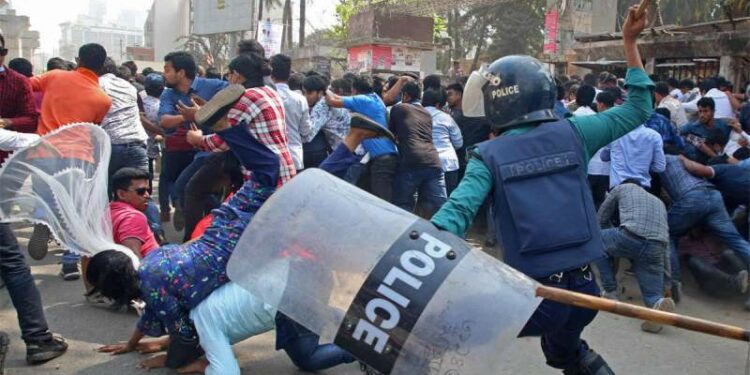This official has been playing a crucial role in supporting secretive Indian missions to retain an ‘unpopular’ Sheikh Hasina in power.

Bangladesh’s beleaguered Prime Minister Sheikh Hasina met at least four senior Indian officials, including a former senior intelligence officer, at Ganabhaban, before confabulating with the country’s three services and security agency chiefs on July 21, Northeast News has reliably learnt.
Senior Indian and Bangladeshi officials deeply familiar with the security measures adopted in the wake of the unprecedented killing of students by the country’s police, Rapid Action Battalion and Border Guard Bangladesh personnel, especially between July 18 and 19, said that the Indian official clandestinely sent to Dhaka to help the Hasina regime suppress the students’ movement and restore order.
Northeast News is withholding revealing the name of the former Indian intelligence official for reasons of security.
This Indian former intelligence officer, who had met Hasina ahead of the so-called general election on January 7, is said to have reached Dhaka on a “day or two” before the Ganabhaban meeting. Three other Indian security officials reached around the same time.
All four gathered in a Ganabhaban conference room on July 21 at a time when Bangladesh’s three services chiefs, including the Army’s General Waker-us-Zaman, and heads of the DGFI and the police, also waited for Hasina to arrive. The Bangladesh Prime Minister, faced with the most serious challenge to her unpopular government, first met the Indians.
Informed sources said that the meeting discussed, among other serious issues, the measures that Hasina’s police, RAB and BGB should take to quell the unrest, even if it required taking harsh measures such as shoot-at-sight orders. For the Indians, the task at hand was to “protect” a government, howsoever unpopular, to achieve other security goals in the region.
Ten days after these two “critical” meetings India’s High Commissioner to Bangladesh, Pranay Verma, met Hasina for at least two hours. While the Hasina-Verma meeting was reported by the media, only “vague” details about the meeting were reported in the Indian and Bangladeshi media.
Nearly two weeks after the worst massacre of students and people in Bangladesh’s history, the Sheikh Hasina government’s move today to ban the Jamaat-e-Islami and its students’ wing, the Islami Chhatra Shibir, is being seen by political observers as a “diversionary tactic”.
This, they said, was a means to justify the brutal crackdown on the students seeking redressal of the skewed quota system that sought to give undue advantage to descendants of the 1971 liberation war, which was done with the purpose of staffing government departments with Awami League sympathisers.
Bangladesh was agog with rumours of Indian involvement in the massacre which, sources said, was “yet another conspiracy” to “link Hasina’s dependence” on security agencies of the neighbouring country.
But what is, however, undeniable is the “shadowy” role played by senior Indian officials in directing Bangladeshi police and security agencies to “put down” the “uprising” by whatever means available at hand.
